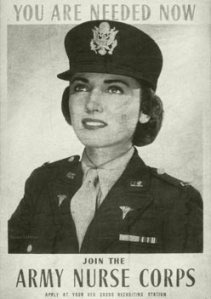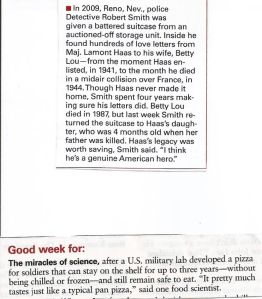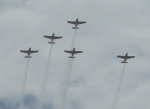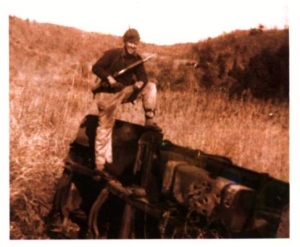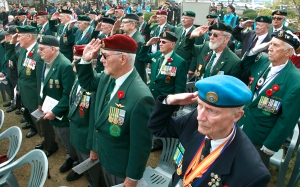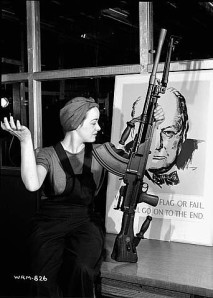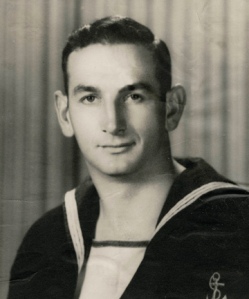Monthly Archives: March 2014
Intermission Stories (7)
Medic, Harold Selley
Harold Selley was in the Medical Company of the 7th Cavalry Regiment from the time time he arrived in Korea, July 1950. He would remain there for 11 months as a medic in a Forward Collecting Station.
Selley related in an interview,” Several times my collecting station was surrounded by the enemy and we were unable to get our wounded to the rear. Most of the time, we medics provided our own perimeter security for the station. That meant we took turns in staying in foxholes guarding our station. Usually we were far enough to the rear of the actual small arms fire that we could operate the station without the enemy invading the area. Since we received wounded from the entire regiment, we saw practically everyone who was wounded in the entire regiment.”
Selley was the main person who saw that the proper tag was given to each casualty. The tag was for identification, brief explanation of the injuries and a record for the regiment. Such records were essential for future medals, disability pensions, statistics, Army files and family information.
Emphasis was on teamwork. “All of us medics in the station were part of a team,” he said. “We knew what to do when a wounded man was sent to us. Often I performed emergency treatment and procedures that the assigned doctor in our station could not do. He was too busy to do it all. We had to pitch in and do everything we could. Often the doctor went from one casualty to another giving advice to the medic as to what should be done.
“The doctor knew the medic’s capabilities. This is not meant to be arrogant in nature. It simply means that we medics treated so many casualties (hundreds) that we became rather proficient. We performed emergency amputations, treated spinal injuries, worked on *pneumothoraxes, did emergency repairs on fractured bones, stopped bleeding, removed shrapnel and attended to shock (most were in shock!).
” Many died before we could get them evacuated to the rear. Dead and wounded were all around us daily. Often we went without sleep during a heavy fighting. I went without sleep for 4 days once, working continuously on wounded.” Selley knew of course that the infantrymen in the frontline battles also went long periods without sleep – for days on end!
“My medical company lost several aid stations, including the doctors and medical personnel. We were always in danger of being attacked by the enemy. The medics assigned to the aid stations in the battalions knew their life expectancy was short. Memory of these men should always heralded as valor and total allegiance to the fighting men, Army and United States.”
For Selley, the memories of being under artillery fire, strafed by planes several times and close to small arms fire will always be remembered. But for him, the most memorable thoughts are the wounded. “I saw about every possible injury that could happen. I got to the point that no injury was too tough to handle, that is, too tough to examine or treat. But, when the wounded died in my hands, that is when I realized I was so inadequate in helping someone. I was drenched in blood most of the time. I tried with all my being to help people live, and when they died, I felt so helpless. I didn’t have time to feel sad or even weep over them. That came later, much later, after I returned from Korea – and still to this day.”
Selley returned to his home and college only to find the younger students did not share his thoughts on America. They had not been through a war and were conditioned to be isolated from the unpleasantries of life. The final line of his story reads – “Let us not make this a forgotten war!”____Harold Selley 2001
*pneumothoraxes: an abnormal collection of air in the area between the lung and chest wall; usually caused by blunt force trauma during combat.
This story was taken and condensed from HERE>
This site is large enough and interesting enough to get lost in for days – enjoy!
#########################################################################
Farewell Salutes –
Alwyn Berland – Toronto, Canada & Chicago, IL; US Navy, WWII
George Allen – Bethesda, MD; US Army, WWII, ETO
Leonard Coleman – Delray Beach, FL; US Army, WWII
Walter “Mick” Hocker – Portland, ME; US Navy, Capt. (Ret.)
Colin G. Mitchel – New Zealand; Australian Imperial Force, WWII # 120010, Cpl., Sig. 35th Infantry Battalion
Raymond Monte – Chicago, IL; US Army, WWII
William Ridenour – Wilshire, OH & Lake Worth, FL; US Navy, WWII
James Skene – Fairview, TX; US Navy, Korea
Edward K. Steffen – Ahwatukee, AZ; US Navy, Vietnam
Andrew A. Turner – Auckland, NZ; Regt. # 596141v, SA Air Force
Nicholas Vitucci – Riverhead, NY; US Navy, SeaBee
Richard J. Watkins – Papatoetoe, NZ; RAF # 4078049, Korea
########################################################################
Airman 1st Class John Perdue decoded secret North Korean codes during war
Many of you have been enjoying my Intermission Stories of the men and women who have served in the military, so it is with great pleasure to include here one of Don Moore’s tributes. I hope you all enjoy the story.
 Airman John Perdue of Punta Gorda, Fla. was just getting out of boot camp in 1950 at Lackland Air Force Base in Texas when this picture was taken. Photo provided
Airman John Perdue of Punta Gorda, Fla. was just getting out of boot camp in 1950 at Lackland Air Force Base in Texas when this picture was taken. Photo provided
Airman 1st Class John Perdue of Punta Gorda, Fla. spent most of his four years in the U.S. Air Force decoding secret messages from the North Korean Air Force during the Korean War of the 1950s.
View original post 700 more words
Intermission Stories (6)
Brigadier General Anna Mae Hays
Anna Mae V. McCabe Hays was born on 16 February 1920 in Buffalo, New York to parents who both were Salvation Army officers. Religion, music and a spirit of service were guiding lights in the McCabe household. After completing high school, Hays attended the Allentown General Hospital School of Nursing.
When approached by a representative of the 20th General Hospital, the University of PA unit, a sense of duty and patriotic fervor inspired Hays to join the Army Nurse Corps. In January 1943, Hay’s unit proceeded to Ledo, Assam, India, 1,000 miles above Calcutta at the beginning of the famous Ledo Road, which cut through the jungles into Burma. She remained there for 2½ years; while she was home on leave, World War II ended.
In the summer of 1950, Hays traveled with the 4th Field Hospital to Inchon, Korea, landing shortly after MacArthur’s invasion operation at Inchon. During both of her combat tours in WWII and the Korean War, Hays spent part of her off-duty time assisting chaplains by playing a field pump organ for weddings and church services, often on the front lines. After receiving enough points to leave Korea, she transferred to Tokyo, Army Hospital and spent another year there.
Her subsequent assignment was Fort Sam Houston Texas followed by three years duty at Walter Reed General Hospital. During that time, she was assigned to be the private duty nurse for Pres. Eisenhower during his brief illness. Hays was married in 1956, but became a widow in 1962. After receiving her bachelor’s degree in nursing education, her next assignment Head Nurse of the Nuclear Medicine and Radioisotope Clinic at the Walter Reed Army Institute of Research.
A return trip to Korea in 1960, she was the chief nurse of the 11th Evacuation Hospital in Pusan, then another tour at Walter Reed, then the Office of the Surgeon General as special assistant to Colonel Harper brought Hays to her selection as Assistant Chief of the Army Nurse Corps 1963-1968. After earning her master of science in nursing degree she served as the 13th Chief of the Army Nurse Corps, 1967-1971.
On 11 June 1970, Colonel Anna Mae Hays was promoted to the grade of general and became the first woman in the United States Armed Forces to wear the insignia of a brigadier general. The Army Chief of Staff, Gen. William Westmoreland and the Sec. of the Army, Stanley Resor officiated at the ceremony. The Army Surgeon General, Hal B. Jennings, pinned the stars on Hays’ uniform.
At the new general’s promotion, she expressed her view that the stars “reflect[ed] the dedicated, selfless and often heroic efforts of Army nurses throughout the world since 1901 in time of peace and war.” She then quoted Albert Einstein’s words, “I must remind myself a hundred times each day that what I am I owe to the lives of other men…and that I must exert myself in order that I may give in the same manner that I receive.” as her philosophy of service to her country.
This wonderful story was taken and condensed from the Army Nurse Corps Association.org website; originally written by Mary T. Sarnecky.
Click on images to enlarge.
#################################################################################
World War II update –
Please to enlarge and read.
#################################################################################
Farewell Salutes –
Jack Alexander (85) – Georgia & Palm Bch., FL; US Air Force, fighter pilot
Aldo Becci – Vienna, VA; US Army, WWII, Transportation Corps
John F. Corrigan – Kelowna, British Columbia, RCAF, WWII, ETO, Wing Commander (Ret.) Distinguished Flying Cross
Susan Curry – Wichita, KS & D.C. – US Army, Lt. Colonel, (Ret.) 27 years
Philip Kneifl – Ft. Worth, TX; US Air Force
Arthur S. Lord – Whakatane, New Zealand; RNZAF # 405576, WWII, 14th Army, Burma
William Pogue – Okemah, OK; US Air Force; Korea, fighter bomber (Astronaut for NASA, 3 SkyLab missions)
William W. Smith – Biloxi, MS & San Diego, CA; US Navy, WWII & Korea
John Taylor – Levittown, NY; US Navy, WWII, Sea Bee
Ben Vasquez – Grand Prairie, TX; US Army, WWII, ETO, Battle of the Bulge
####################################################################################
Intermission Stories (5)
Corporal Hiroshi “Hersey” Miyamura
Hersey Miyamura, a young Nisei Army Corporal distinguished himself by conspicuous gallantry and intrepidity above and beyond the call of duty in action against the enemy near Taejon-ni, Korea on 24-25 April 1951.
On the night of 24 April, Company H was occupying a defensive position when the enemy fanatically attacked, threatening to overrun the position. Miyamura, a machine-gun squad leader, aware of the imminent danger to his men, unhesitatingly jumped from his shelter, wielding his bayonet in close hand-to-hand combat, killing approximately ten of the enemy. Returning to his position, he administered first-aid to the wounded and directed their evacuation.
As another savage assault hit the line, he manned his machine-gun and delivered withering fire until his ammunition was expended. He ordered the squad to withdraw while he stayed behind to render the gun inoperative. He then bayoneted his way through infiltrated enemy soldiers to a second gun emplacement and assisted in its operation. When the intensity of the attack necessitated the withdrawal of the company, Corporal Miyamura ordered his men to fall back while he remained to cover their movement.
He killed more than fifty of the enemy before his ammunition was depleted and he was severely wounded. He maintained his magnificent stand despite his painful wounds, continuing to repel the attack until his position was overrun. When he was last seen by his men, he was fighting ferociously against an overwhelming number of enemy soldiers.But, it was only the beginning of a long night. Wounded, he struggled to safety, engaging in only brief encounters with the enemy. By dawn, the exhausted corporal was playing dead in a ditch as hundreds of the enemy walked past his body, but one Chinese officer was not fooled and Hersey was taken prisoner.
For 28 months he struggled to survive and for more than a year, his family did not know if he was dead or alive; the Chinese had not released his name as a POW. Unaware that due to his own courage, many of his men had reached American lines, Miyamura believed they were all wounded or dead.
It was 23 August 1953 when he was escorted by his captors to the Freedom Village near Panmunjom. Then, Hersey heard a strong voice inquire, “Are you Corporal Hiroshi H. Miyamura?” He thought momentarily that the MPs were to take him into custody to await his court martial. To his amazement, the general extended his hand with the announcement, “Congratulations. You’ve been awarded the Medal of Honor.”
For the young Nisei corporal, this was unbelievable. Just as the Chinese had kept to secret of his capture, the US Army had maintained the secret of his award. He was later told that had the Chinese captors known of this honor, “You might not be here, alive, today.” Two months later, 27 October 1953, Pres. Dwight D. Eisenhower shook Miyamura’s hand and placed the medal around the neck of the Japanese-American boy from Gallup, New Mexico.

“Hersey” (center) w/ friends in Gallup, NM for the Hiroshi Miyamura High School dedication Oct. 2010
An update, courtesy of Partnering With Eagles, we have Mr. Miyamura’s obituary, he was 97-years old.
OBITUARY: Hershey Miyamura, 97; Medal of Honor Recipient for Korean War Heroism
Click on images to enlarge.
This information is courtesy of Home of the Heroes.com; http://www.nj.gov and 100th battalion.org
############################################################################
Click on images to read a heartwarming WWII update and a very unique upgrade for our current military…
###########################################################################
A Farewell Salute video from fellow blogger Carl D’Agostino.wordpress.com/
Two Air Firce pilots, Major Howard V. Andre, Jr. and Major James E. Sizemore, MIA since the Vietnam War return home.
Watch HERE>
###########################################################################
Lucille Camarota – McKees Rock, PA & D.C.; US Army Nurse Corps, Captain
Virgil Dunn – Rowlett, TX; US Army Air Corps, WWII, PTO
John Frankowski, Sr. – New Hyde Park, NY; US Army, Vietnam
Charles W. Menifee – Nakina, Ont.; RCAF, WWII, ETO
Harold Mouser – Wichita, KS; US Army, Lt.
Michael Scanlon – Gainsville, VA; USMC, Colonel (Ret.) 32 years
Maurice J. Walker – Christchurch, NZ; RNZAF # 425958, navigator F/Sgt., WWII
###########################################################################
Wednesday Hero: Maj. Don Beerbower
This is one post from Jacqui Murray’s Wednesday Hero collection. I sincerely hope you will join us in honoring Major Don Beerbower of the 9th U.S. Air Force. Thank you.
 Maj. Don Beerbower
Maj. Don Beerbower
 22 years old from Hill City, Minnesota
22 years old from Hill City, Minnesota353d Fighter Squadron, 354th Fighter Group, 9th Air Force
August 26, 1921 – August 9, 1944
A fighter pilot who has brought down five or more enemy aircraft was called a flying ace. From December 1943 to Aug. 9, 1944, Beerbower became a triple ace, shooting down more than 15 German planes, making him the second highest ace in the 9th Air Force.
Due to pilot losses and Beerbower’s own advancements based on flying and leadership skills, Beerbower was promoted to major and made squadron commander in June 1944 — less than nine months after his arrival in Europe. At only 22 years old, he already was a great fighter pilot, respected and liked by the men in his squadron.
You can read more about Maj. Beerbower hereThese brave men and women sacrifice so much in their lives so…
View original post 71 more words
Intermission Stories (4)
There are beautiful memorials to the Korean War veterans all around this world of ours, the following is the memorial poem at the Liberty State Park. Fellow blogger, Gallivanta, was kind enough to submit these sentiments for this site. It would be wonderful if readers would take the time to see her site as well, it can be found HERE.
We didn’t do much talking, We didn’t raise a fuss. But Korea really happened, So please – remember us. We all just did our duty, But we didn’t win or lose. A victory was denied us, But we didn’t get to chose. We all roasted in the summer, In winter, we damn near froze. Walking back from near the Yalu, With our blackened frozen toes. Like the surf the Chinese kept coming, With their bugles in the night. We fired into their masses, Praying for the morning light. All of us just had to be there, And so many of us died. But now we’re all but half forgotten, No one remembers how we tried. We grow fewer with the years now, And we still don’t raise a fuss. But Korea really happened, So please – remember us.Click on images to enlarge.
###################################################################################
I know how much eye witness accounts and the Farewell Salutes mean to the readers of this site, therefore I wish to introduce you to Jacqui Murray, should you not already be acquainted. Her site is USNA or Bust and every Wednesday she posts the Wednesday Hero. I thought you might enjoy having a link to go take a peek at the wonderful veterans she has honored. Located here.
###################################################################################
A WWII Update –
Please click to enlarge this powerful story from The Week magazine…
###################################################################################
Farewell Salutes –
Brandon Tyler Bennett (20) – Lewisville, Tx; Texas Army National Guard, 176th Engineer Brigade
Russell A. Bertram – Toronto, Canada; Royal Can. Army Medical Corps Band, WWII
Walter G. Bruhl, Jr. – Newark, NJ & Dewey Beach, DE; USMC, Sgt., Korea
Sammy Countryman – Roger, AR; Us Army, Korea, Helicopter instructor during Vietnam
John Lewis Chambers – Lantana, FL; US Air Force, Korea
Francis Flynn – Sun Lakes, AZ; US Army Air Corps, WWII, pilot
LeRoy “Peanuts” Holmberg – Cloquet, MN & Boca Raton, FL; US Army, WWII
Damiel Murphy – Pearl River, NY; US Army, WWII
Malcolm A. Newton – North Island, NZ; RNZN #18141
Edward K. Steffen – Ahwatukee, AZ; US Navy, Vietnam
John Theus – Jacksonville, FL; US Army Air Corps, Col. WWII, US “Flying Tigers”, PTO
Ernest Tollerson, jr. – Washington, DC; US Army, Pvt., WWII / Lt.Col., Korea & Reserves
###################################################################################
Intermission Stories (3)
A KOREAN VETERAN LOOK BACK
Bill Campbell, 3rd Battalion, Royal Canadian Regiment
Bill Campbell was born in Glace Bay, N.S. on Breton Island, the son of a coal miner who passed away at 35 years of age, leaving his wife with 5 kids in the middle of the Great Depression. Times were tough, but Mrs. Campbell raised them all on meager means.
In 1950, when the call went out for volunteers, the response was remarkable, as over 27,000 joined the Armed Forces of Canada to fight in a country they had never heard of. Some would not return. Bill joined up in Toronto and after training in Camp Petawawa, he was sent to Seattle to ship out for Japan and Korea. “We left Seattle on a liberty ship…Most of the soldiers were really excited to travel to distant lands. There were 2500 troops aboard, most of whom were American draftees. They could not believe we were volunteers. We laughed at them. We were so gung-ho! This would all change when we reached the front lines.”
“When we approached Korea, just as dawn was appearing over the horizon, a band awaited us at the dock of Pusan, playing, “If I Knew You Were Coming, I’d A Baked A Cake,” a song which was popular at that time. We were now in Korea, the “Land of the Morning Calm”. The smell of the rice paddies (Fertilized with night soil) permeated the air, but dissipated as we journeyed North to the front lines by train. One of the saddest moments on this trip was the incredible sight of orphans, many missing limbs begging for food and other hand-outs. These memories never left us. There were atrocities on both sides, but the Korean people somehow prevailed and overcame that difficult time.
The landscape in Korea was a delight to behold. Beautiful mountains dominated the panorama. The summer weather was hot; wet when the monsoons came with a furor. In winter, the severe cold winds swept down from Siberia and Manchuria, causing temperatures to plummet to -25 Fahrenheit. I still remember vividly the peaceful scenery of the Yonchon (Hill 187) area where white cranes came to alight on tree branches like snowflakes, when heavy bombardment reposed momentarily.
I ask my fellow vets whether they ever regret the decision to serve in Korea and they respond, unanimously that they would do it all over again. They were proud with what they had achieved.
This story found at – KVACanada.com with a link HERE.
###############################################################################
Fellow blogger, Atomis Scout has an outstanding post on a WWII Canadian female icon, “Ronnie, The Bren Gun Girl” found HERE.
###############################################################################
Vince “Cyclone McGlone
Auckland’s Vince “Cyclone” McGlone, a gunner aboard one of the 3 Royal Navy Ships to pursue the German battleship, Graf Spee to its doom in December 1939, died at age 97. One of the last survivors in the Battle of the River Plate, from either side, became better known for his gruff but strong reciting of the national anthem. HMS Achilles was part of the Royal Navy’s New Zealand Division.
Rear Admiral Jack Steer said, “Vince was a great character who loved to visit Devonport Naval Base and yarn with today’s generation of sailors.” McGlone enlisted as a boy sailor just shy of his 16th birthday; 2 years later, he was promoted to seaman and posted to the Diomede as a gunner; soon after he was promoted to able seaman and boarded the HMS Achilles.
They were patrolling South American waters when it opened fir on the Graf Spee, a battleship far superior in its fighting capabilities, on 13 December 1939. In 82 minutes, the gunners fired in excess of 220 broadsides at the enemy ship, forcing her to retreat to Montevideo where she was scuttled 4 days later. “The Spee should have blown us out of the water. We were laid down to go 32 knots and in the battle we got up to 35. They weren’t expecting that speed and so we put them off their aim.” McGlone said the ship burned for 3 days and they celebrated aboard the Achilles, “Unfortunately there was no open bar on the ship.”
McGlone wore 6 medals, including: the Atlantic Star, the Pacific Star, the British War Medal, the New Zeland War Medal, the New Zealand Occupational Medal and the Japanese Occupational Medal.
This information was brought to my attention by our fellow blogger, Haley from Tall Tales. me found HERE.
Click on photos to enlarge.
##########################################################################
Farewell Salutes –
Peter W. Baron – England & Canada; Royal Navy, WWII
David Colflesh – Kansas, Long Island & W.Palm Beach, FL; US Army, WWII, Colonel (Ret.)
Clifford Corbier – Glendale, AZ; US Army, MSgt., Korea
Dana “Dutch” Fisher – San Diego, CA; US Navy, WWII, USS Torrance
James Kealey – Hinsdale, IL; US Army, WWII
Harold Lichtenstein – Washington, DC; US Army, WWIIRoland V. Rakow – Miami, FL; US Army Air Corps, WWII, No. Africa, 83rd Squadron, POW – escaped
Glen McDuffie – Dallas, TX; US Navy, WWII, (the famous “Kissing Sailor” photo)
Harvey Perritt, Jr. – Tabb, VA; US Army, Colonel, (Ret.), Vietnam, 2 Silver Stars, Bronze Star, Purple Heart, 8 Air Medals
Harold B. Nelson – Rotorua, NZ # 437324, 14th Fighter Squadron
William Vaugham – Silver Spring, MD; US Army Air Corps, WWII, ETO
############################################################################
Intermission Stories (2)
Captain Lillian Kinkela Keil
By the time 1950 and the Korean War came around, about one million women had worn the uniform from the United States military. They had been prisoners of war, been wounded, flew planes, planned strategies, nursed casualties and died for this country. Hundreds of women flew air evacuation, caring for the wounded soldiers during every bumpy air mile one of these women was Capt. Lillian Kinkela, a member of the Air Force Nurse Corps and one of the most decorated women in the U.S. military.
The captain flew over 200 air evacuation missions during WWII as well as 25 trans-Atlantic crossings. When the Korean War erupted, she donned her uniform once more and flew several hundred more missions as a flight nurse in Korea. Capt. Kinkela Keil was the inspiration for the 1953 movie “Flight Nurse” and served as the technical adviser during the making of the film.
Her decorations include: the European Theater of Operations w/ 4 Battle Stars; The Air Medal w/ 3 Oak Leaf Clusters; The Presidential Unit Citation w/ One Oak Leaf Cluster; The Korean Service Medal w/ 7 Battle Stars; The American Campaign Medal; The UN Defense Medal; Presidential Citation, Republic of Korea.
Capt. Keil’s older brother was killed during WWII while serving in the US Navy. Lillian married Walter Keil, a Naval intelligence officer who served on Guadalcanal during WWII. She passed away June 2005 at the age of 88.
This information was supplied by: The National Museum. af.mil/
##################################################################
The BIG TEN – the first inland demolition raid in Korea by Team 3
We can all agree that there is nothing like a personal account of an event to bring things into perspective and reality. This story is too long for me to repeat here word-for-word without cropping out too much vital information, so I am just leaving the link for you to decide as to its interest and importance.
http://www.navyfrogmen.com/PhilCarricoFirstInlandRaid.html
###################################################################
Sir James Plimsoll and UNCURK
A civilian in war
Sir James Plimsoll had a significant influence during the Korean War as Australia’s delegate to UNCURK (United Nations Committee for the Unification and Rehabilitation of Korea). The group was formed in October 1950 with the anticipation of a speedy end to the war. By the time the committee had their first meeting in November, the Chinese had entered the scene.
Most UNCURK personnel recommended leaving Korea, but Plimsoll argued to the contrary by bringing the point that their civilian presence should clearly remain. They did stay, but moved to Pusan along with the South Korean government. Although their original purposes were altered by events, the commission played a valuable role over the following years. They remained in constant contact with the ROK government officials, observed elections and reported news to the UN.

L to R; unknown person, Plimsoll, Rhee, R.G. Casey, Pote Sarasin (Thai delegate) & Alan Watt (US Dept. of External Affairs)
Sir James was a foreign adviser with considerable influence on Pres. Syngman Rhee. He would explain the views of the UN and pointed out to Rhee his tendency to disregard norms of democracy and human rights. Sir James returned to Canberra to take up a different position, but in February 1952, the US State Dept. delegate requested him back to Korea; his influence had greatly been missed.
Following the war, Sir James Plimsoll held several high official positions representing Australia around the world and then as Governor of Tasmania; dying in office 1987.
This information is courtesy of www.awm.gov.au/ “Out in the Cold”
###########################################################################
Farewell Salutes –
Robert Amundsen, Sr. – Dallas, TX, US Navy, WWII
Wilhelmina Buck (nee McGill) – Manurewa, NZ; RNZAF #3376, WAF, WWII, Whenuapai Air Base
Bryan V. Cady, Jr. – Ogden, UT, US Army, Korea
Eugene Cirzan – Sun City, AZ; US Army, Korea
Donald W. Cropp – W.Palm Beach, FL; US Army, Korean War
Joseph Kapala – Tinley Park, IL; US Army, WWII, Battle of the BUlge, Purple Heart
George Manzell – Tauranga, NZ; Merchant Navy, WWII # R233179; British Army, Sgt.RA, Korea # 14460567
James Semradek – Park Ridge, IL; US Army, WWII, ETO, Purple Heart
#############################################################################
Intermission Stories (1)
Personal note – The posts listed under the title of Intermission Stories will be numbered just as the Korean War series is. These will be first hand stories, events missed, pieces I found to be interesting, obituaries and my own experience climbing into a B-17 “Flying Fortress.” (Try not to laugh too hard at that one.) This will enable me to gather and try to organize the data I have accumulated for the forthcoming WWII series.
Please remember – all of your stories are welcome in the comments and they need not be only of these two wars; some of you are current members of the military and some are civilians with home front experiences. If you have a post or web site dedicated to a veteran and/or event, please supply a link so that all of us can read it.
Thank you ALL for your loyalty, friendship and willingness to participate with me in our goal to REMEMBER!
#############################################################################
Band of Brothers Obituary
William “Wild Bill” Guamere – one of the World War II veterans whose exploits were dramatized in the TV miniseries “Band of Brothers” has dies; he was 90 years old. He was a member of Easy Company, 506th Regiment, 101st Airborne Division.
His exploits during some of the fiercest battles of the European Theater earned him his nickname and cost him his leg while trying to help a wounded soldier during the Battle of the Bulge. His commendations included the Silver Star, two Bronze Stars and two Purple Hearts.
When he returned from the war, Guarnere lived in the row house in South Philadelphia, where he would eventually reside for 60 years. He worked in construction despite his disability and helped to put together Easy Company reunions. In 2007, he helped to write, “Brothers in Battle, Best of Friends,” with fellow veteran Edward J. “Babe” Heffron and journalist Robyn Post.
Babe Heffron and Wild Bill met during the war and remained friends until Heffron died 1 December 2013,
also 90 years of age and a Bronze Star recipient. Guarnere”s son said, “Now they’re together again.”
The viewing is set for tomorrow, Thursday, at Ruffenach Funeral Home in Philadelphia and the funeral will be held this Friday.
**This information supplied by FoxNews.
############################################################################
Please click to enlarge this inspirational story of survival.
Information supplied by “The Week” magazine.
###############################################################################
Farewell Salutes –
Sanford Ames – Takoma, MD; US Army, WWII
Frederick Cavlovic – Cleveland, OH & N.Palm Beach, FL; US Army, WWII, PTO
Russell Clanahan – Springfield, VA; US Navy, Korea
Colin Gibson – Wheaton, MD; US Navy, WWII, PTO, medical team
Kathleen Grasmeder – Colonial Beach, VA; US Army (Ret.)
Carroll Jordon – Chickasaw, AL; veteran of Korea, targeted and brutally beaten and stabbed by 3 youths.
Spero Kitsakos – Brooklyn, NY & W.Palm Beach, FL; US Navy, WWII
Edward Makowski – Chicago, IL; US Army, WWII
Frank Owen – Ste-Agathe, Quebec; British Columbia 28th Canadian Armoured Regiment (Duke of Connaught’s Own), Major (Ret.)
Edward Touhy – Chicago, IL; US Navy, WWII
Norman Wetzel – Union Bridge, AR; US Army, WWII, 3rd Armored/813th Engineer Corps/29th Division
Charles Zeigman – Manchester, AR; US Army, Korea
#########################################################################
Korean War Statistics
Personal note – The resources I have used throughout this Korean War project all vary in the total statistics; therefore I have been forced to give the readers the range [highest and lowest] or the only amount located.
#########################################################################
United States – of the 1,319,000 men that served – 33,629 to 54,246 were KIA – – 92,134 to 103,284 were WIA
Republic of Korea – 58,127 to 59,000 were KIA – – 175,743 were WIA and ~ 80,000 MIA
Great Britain – 1,109 were KIA – – 2,674 to 4,817 were WIA and 1,060 MIA
Canada – Of 25,000 who served – 516 were KIA and 1,042 were WIA
Australia – Of 17,000 served – 281 to 339 were KIA and 1, 050 were WIA
New Zealand – Of 3,794 who served – 33 were KIA – – 79 were WIA
Turkey – 717 to ~900 KIA – – 2,111 to 3,500 WIA and 168 MIA
South Africa – Of the 826 served – 28 were KIA – – 8 were MIA
Netherlands – 110 KIA
France – 300 were KIA or MIA
Philippines – 112 were KIA
Greece – 170 were KIA
Belgium – 100 were KIA
Thailand – 110 were KIA
Ethiopia – 120 KIA
Columbia – 140 were KIA
**********************************************************************************************
From Western resources – North Korea had 215,000 men KIA and 303,000 listed as WIA. Chinese troops were down as 400,000 as KIA and 486,000 as WIA.
From Chinese resources – North Korea suffered 290,000 KIA and China listed themselves as – 144,000 KIA – 340,000 WIA – 7,600 as MIA
Civilian casualties in both North and South Korea could only be estimated and those numbers ran from 400,000 to well into the millions.
##########################################################################
India had chosen not to participate in the fighting, but they did send the 60th Parachute Field Ambulance unit which was included in the 1st Commonwealth Division. The Indian Paratroop Battalion/315 Air Division were deployed later as part of the Custodial Forces sent to enforce the demilitarized zone.
The US Air Force 374th Troop Carrier Wing, throughout the war, performed air lifts and air drops; after the cease-fire, using the C-124 Globemaster, they moved the repatriated prisoners. By the end of the war, they had earned their 4th DUC.
Click on images to enlarge.
##########################################################################
Samuel Applewhite III – Oakland, CA & Scottsdale, AZ; US Army, Korea
Vincente Blaz – Fairfax, VA; USMC (Ret.)
Donald Boyd – Boone, Iowa & Sun City, AZ; US Army Air Corps, WWII
Lawrence Hammar- Kerkeley, IL; US Army, WWII, PTO
Patrick A. Lindsay – born: Tipton, England, died: Village Point-Claire, Quebec; Royal Navy, WWII, HMS Brocklesby
Allan A.C. Riordan – Christchurch, NZ; RNZAF # 72855, WWII, Malaysia
Cyril Shaller – EauClaire, WI; US Navy, WWII
Albert Taylor (Burt) Taylor – Christchurch, NZ; NZEF # 290465
Joseph Vito – Chicago, IL; US Navy, WWII
#########################################################################








